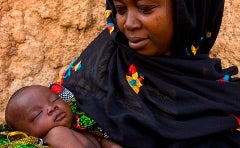 Let's think together: Every Sunday the World Bank in Tanzania in collaboration with The Citizen wants to stimulate your thinking by sharing data from recent official surveys in Tanzania and ask you a few questions.
Let's think together: Every Sunday the World Bank in Tanzania in collaboration with The Citizen wants to stimulate your thinking by sharing data from recent official surveys in Tanzania and ask you a few questions.
Pregnancy and childbirth can be a tremendously exciting time for a family if the expectant mother and her unborn child benefit from quality medical services and the baby is delivered in a safe environment.
However, it can also be a traumatizing experience if the mother loses her life during childbirth or if the newborn is sick or dies.
In Tanzania many mothers and mothers-to-be are dying young and unnecessarily as illustrated by the following statistics:
- Tanzania’s maternal mortality ratio is estimated at 460 deaths per 100,000 live births (in 2010); 8,500 women are dying every year because of pregnancy or childbirth.
- Maternal mortality has declined since 2005 (from around 610 deaths per 100,000 live births), but progress has been much slower than with child mortality.
- Tanzania’s maternal mortality ratio also appears high compared to other countries, such as India (200), Kenya (360), Ethiopia (350) or Senegal (370).
The broader problems caused by poor reproductive health are far greater than what is suggested by these mortality statistics. For every maternal death, many more women suffer from pregnancy- or childbirth-related impairments, often with long-term negative impacts on their health and labor force participation. And of course, maternal health is closely linked to the wellbeing of newborn children.
A major factor behind the high levels of maternal mortality in Tanzania is the insufficient utilization of reproductive healthcare services:
- While the World Health Organization recommends that pregnant women (without complications) should have at least four visits to an antenatal care provider, 57 per cent of Tanzanian women had fewer visits in 2010.
- 56 per cent of rural and 17 per cent of urban births were delivered at home, rendering advanced medical treatment difficult to access in case of complications. In the poorest quintile almost two-thirds of births occurred at home.
- In 2010 alone, around 900,000 births (49 per cent) were not attended by a skilled provider: 15 per cent of births were attended only by a traditional birth attendant, 29 per cent were attended only by relatives or friends and just above 3 per cent of births (more than 60,000) were delivered without any assistance.
This underutilization of reproductive health services is related to poor accessibility and the cost associated with seeking care. Another yet related reason is the poor quality of reproductive health services. In 2010, only around half of the women (53 per cent) who received antenatal care were informed about potential pregnancy complications. Unlike healthcare needs of children, which are often addressed through large-scale immunization campaigns and other ‘vertical’ programs, reproductive healthcare needs are addressed through the general healthcare system, which suffers from the well-known problems of weak staff incentives, poor accountability and inadequate service delivery.
All of this raises the following questions:
- What are the most important factors deterring women from seeking antenatal care and delivering their babies at hospitals? Distance? Road infrastructure? Cost? Poor quality of service?
- Can better education for girls reduce maternal mortality? Or would it be more effective to offer expectant mothers financial incentive to seek pre- and post-natal care?
- How can the quality of maternal health services be improved? Through incentive-based pay for healthcare personnel? Better equipped facilities?
- Is maternal health mainly the responsibility of the women themselves? What is the role of their husbands?
- Should Government step up family planning programs to further reduce fertility and the risk of mothers dying during childbirth?
Note: The statistics above are based on the 2010 Demographic and Health Survey and the World Bank’s Gender Statistics Database. Data from these sources are publicly available and results can be replicated.




Join the Conversation